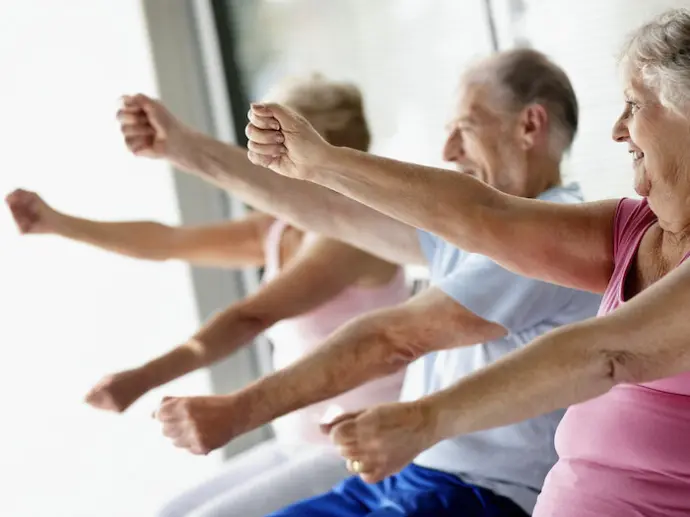Your journey of wellness starts here
Parkinson’s Disease
Parkinson’s Disease (PD) is a progressive neurological disorder characterized by the gradual loss of nerve cells in the substantia nigra, a brain region essential for movement control. This loss leads to decreased dopamine production, resulting in common physical symptoms such as tremors, muscle stiffness, and balance issues.
In addition to motor symptoms, individuals with PD may face cognitive and emotional challenges, including memory loss, sleep disturbances, fatigue, and depression. Symptoms typically develop slowly and worsen over time. Notably, by the time of diagnosis, approximately 50% of dopamine-producing neurons are already lost.
Physical therapy plays a crucial role in managing Parkinson’s Disease by improving mobility, enhancing balance, and reducing stiffness. Tailored exercise programs can help maintain function and improve quality of life for those living with PD.
Signs and Symptoms
Common Symptoms Include:
Tremors
Involuntary shaking in the hands, arms, head, jaw, or legs.
Poor Balance
Difficulty maintaining posture, especially when standing still or rising from a seated position.
Walking Difficulties
Small, rapid, or shuffling steps (known as festinating gait).
Slowness of Movement
Noticeable swaying while standing still.
Increased Swaying
A noticeable reduction in speed (bradykinesia).
Decreased Automatic Movements
Reduced blinking or lack of arm swinging while walking.
Soft Speech
Speaking quietly or with reduced vocal strength.
Psychotic Symptoms
Hallucinations or other mental health issues.
Dizziness
Frequent episodes of lightheadedness.
Drooling
Excessive saliva production.
Constipation
Difficulty with bowel movements.
Delays in Initiating Movement
Difficulty starting movements (akinesia).
Dystonia
Involuntary muscle contractions leading to repetitive or twisting movements.
Muscle Rigidity
Stiffness that restricts motion.
Stooped Posture
A tendency to lean forward or have balance issues when upright.
Sleep Issues
Sudden movements during sleep or disturbances in sleep patterns.
Facial Masking
Diminished facial expressions.
Micrographia
Changes in handwriting, often becoming smaller and harder to control.
Lack of Motivation
Decreased drive or initiative.
Fatigue
Persistent tiredness or lack of energy.
Diminished Sense of Smell
Reduced ability to detect odors.
Depression
Feelings of sadness or hopelessness.
Risk Factors
Understanding the risk factors can help in early identification and management. Here are the key factors:
Advancing Age
The most significant risk factor for developing PD. Most diagnoses occur around age 60 or older, with risk increasing significantly by age 85. Cases diagnosed before age 60 are referred to as ‘young-onset Parkinson’s disease’.
Gender Disparity
Men are more frequently diagnosed with Parkinson’s Disease than women.
Family History
Having one or two close relatives with PD increases the risk, although the overall risk remains low unless multiple family members are affected. Approximately 10-25% of diagnosed individuals have a genetic link, while most do not inherit the condition. Some genetic mutations may increase risk, but not all carriers develop the disease.
Toxins and Exposure
Environmental factors such as pollution, heavy metals, pesticides, herbicides, and exposure to certain toxins may contribute to the onset of PD.
Traumatic Brain Injury (TBI)
Evidence suggests that a history of TBI or repeated head trauma (e.g., in boxers) may elevate the risk of developing PD. Serious brain injuries can lead to the accumulation of alpha-synuclein, a protein associated with nerve cell deterioration.
Ethnic Variations
Research indicates that White populations generally have the highest prevalence of PD. However, individuals of Hispanic or Black ethnicity diagnosed with PD may face a higher risk of severe cognitive impairment.

Diagnosis and Examinations
At our physiotherapy clinic, we understand that diagnosing Parkinson’s disease can be a complex process. Currently, there is no single definitive test for this condition. Instead, healthcare providers rely on a comprehensive approach that includes a patient’s medical history, observed symptoms, neurological assessments, and a thorough physical examination.
Parkinson’s disease is often identified when noticeable movement-related symptoms emerge, such as:
- Tremors
- Muscle stiffness
- Balance issues
- A shuffling gait
- Slowed movement
However, recent research indicates that non-motor symptoms may appear even earlier. These can include:
- Loss of smell
- Dizziness
- Constipation
- Sleep disturbances
- Depression
If Parkinson’s disease is suspected, patients are typically referred to a neurologist—an expert in nervous system disorders—for further evaluation and diagnosis.
Imaging techniques such as MRI, PET scans, and ultrasounds may also be utilized. In certain cases, a dopamine transporter scan (DaTscan) can provide insights into dopamine activity in the brain, though it is less commonly used due to its cost.
Diagnosis is determined through a comprehensive analysis of these evaluations and test results.
Examinations
To accurately diagnose neurological conditions, a variety of assessments may be conducted, including physical, neurological, and imaging tests. The physical examination involves visual inspection, palpation, percussion, and auscultation to evaluate muscle and limb function. Neurological assessments focus on mobility, reflexes, sensory responses, coordination, and memory.

Pharmacological Interventions
Managing Parkinson’s disease (PD) involves a comprehensive approach, including pharmacological interventions that target both the underlying physiological changes and the symptoms associated with the condition. While no medication can reverse or halt the progression of PD, various treatments can significantly improve quality of life.
Understanding Dopamine and Its Role
The treatment for Parkinson’s typically begins with medications aimed at restoring or mimicking the effects of dopamine in the brain, or preventing its breakdown. One of the most commonly prescribed medications is **levodopa**, an amino acid that the body converts into dopamine. Since its introduction in the early 20th century, levodopa has remained a cornerstone of PD treatment.
Enhancing Levodopa Treatment
To enhance the effectiveness of levodopa and minimize side effects, it is often combined with **carbidopa** to create **Sinemet**. Carbidopa facilitates the transport of levodopa across the blood-brain barrier and improves its efficacy, especially in extended-release formulations. Today, Sinemet is widely regarded as the gold standard for treating Parkinson’s disease.
Additional Medications
Dopamine Agonists
These drugs mimic the activity of dopamine in the brain.
COMT Inhibitors
These also work to preserve dopamine levels in the brain.
MAO-B Inhibitors
These medications slow the breakdown of dopamine, helping to maintain its levels.
Anticholinergics
These are used to help control tremors associated with PD.
Personalized Treatment Plans
The selection of appropriate pharmacological interventions is tailored to each individual, taking into account factors such as age, overall health, lifestyle, and specific symptoms that may interfere with daily activities like walking, balance, or hand coordination.
Managing Side Effects
It is crucial to understand that dyskinesia is a side effect of medication, not a symptom of Parkinson’s disease itself. While this can be challenging for patients, many choose to continue their medication regimen, as the benefits of improved mobility and symptom control often outweigh the side effects.
Rehabilitation
Rehabilitation plays a crucial role in managing life with Parkinson’s disease (PD). While it cannot reverse the condition, its main goal is to slow its progression and help individuals maintain their independence for as long as possible. Rehabilitation targets specific symptoms to help maximize daily functioning. Physical therapists often tailor treatment to support personal goals and lifestyle needs.
Exercise is especially beneficial for people with Parkinson’s, as it can influence how dopamine is utilized in the brain. Since each person’s experience with Parkinson’s is unique, physical therapists create customized exercise programs to manage specific symptoms like tremors, poor balance, or handwriting difficulties. These programs typically incorporate exercises that promote strength, balance, flexibility, endurance, and coordination.

Movement Strategy Training
To enhance movement coordination and fluidity, techniques such as reciprocal training, exaggerated movement training, and dual-task training are employed in physical therapy. These methods help patients reestablish natural movement patterns, practice multitasking while walking, and visualize movements for improved execution. Together, they create a comprehensive approach to restoring smoother and more coordinated movements.

Cardiovascular (Aerobic) Exercise
High-intensity aerobic exercise can significantly aid individuals with Parkinson's Disease (PD) by slowing cognitive decline and motor skill deterioration. These workouts improve physical health, reduce depression, and enhance overall quality of life. Aim for about 2.5 hours of exercise per week, with long-term programs (six months or more) offering the most benefits. Even small amounts of activity are helpful, but consistency is key. Consult your physical therapist for personalized workout recommendations.
Strength Training
Using weights can build strength, especially in the lower body, which is essential for maintaining balance. Strength training also helps reduce movement slowness (bradykinesia) and improves mobility for daily tasks. Training both the upper and lower body has been shown to help people with Parkinson’s move more efficiently.

Balance, Posture, and Fall Prevention
Parkinson's disease impacts dopamine production, leading to difficulties in movement initiation and automatic actions, which can affect posture and balance. This increases the risk of falls. Physical therapists provide targeted exercises to improve balance and posture, along with strategies to minimize fall risks at home and during daily activities.
Therapeutic Exercise Types
Rehabilitation is essential for managing Parkinson’s disease (PD), focusing on slowing its progression and helping individuals maintain independence. Physical therapists customize treatment plans to address specific symptoms and personal goals. Exercise plays a vital role, positively affecting dopamine utilization in the brain. Tailored exercise programs target symptoms such as tremors, balance issues, and handwriting difficulties, incorporating activities that enhance strength, balance, flexibility, endurance, and coordination.


Interdisciplinary Approach in Rehabilitation
At our physical therapy clinic, we understand that managing Parkinson’s disease often requires a multidisciplinary approach. Our physical therapists may recommend collaborating with other healthcare professionals to enhance your rehabilitation experience.
Occupational Therapy (OT): Our team may refer you to an occupational therapist who specializes in improving fine motor skills essential for daily activities such as dressing, bathing, cooking, and writing. OTs can also suggest home modifications to minimize fall risks and promote greater independence.
Speech-Language Pathology (SLP): If you experience challenges with voice volume, speech, swallowing, or facial expressions, your physical therapist may recommend consulting a speech-language pathologist. SLPs are trained to address communication concerns and help improve your overall quality of life.
By working together with these specialists, we aim to provide comprehensive care tailored to your unique needs in managing Parkinson’s disease.
Ongoing Research
Ongoing research continues to explore new rehabilitation strategies, exercise methods, and therapy techniques that may improve quality of life for people living with Parkinson’s disease.
The medical community’s knowledge of Parkinson’s disease (PD) continues to expand through ongoing and comprehensive research. Scientists are working to better understand the causes and progression of PD to improve early detection, diagnostic accuracy, and treatment effectiveness. Current research efforts focus on several key areas:
Biomarkers for Early Detection of Parkinson's Disease
Research is focused on identifying biological markers that can detect Parkinson's Disease (PD) in its earliest stages, even before symptoms become apparent. Currently, by the time a diagnosis is made, it is estimated that 40-50% of dopamine levels in the brain may already be depleted. Early detection of PD could lead to significantly better treatment outcomes.
Alpha-Synuclein Research
Alpha-synuclein is a protein that, when misfolded, forms clumps known as Lewy bodies in the brains of individuals with Parkinson's disease (PD). These clumps interfere with normal brain function. Researchers are actively investigating methods to halt or reverse this aggregation process, including the potential development of vaccines aimed at preventing the harmful accumulation of alpha-synuclein.
Cellular Function
Research into mitochondrial dysfunction, irregular oxygen utilization, gut bacteria, and chronic inflammation is shedding light on how these cellular processes may lead to dopamine loss and the progression of neurodegenerative diseases. These mechanisms are also observed in conditions such as Alzheimer’s, ALS, and Lewy body dementia, indicating potential common pathways across various disorders.
Genetics and Drug Development
Ongoing genetic research aims to identify mutations that increase the risk of Parkinson's disease (PD). Meanwhile, scientists are developing more effective medications, including innovative drug-delivery pumps that provide a continuous flow of treatment. These advancements help mitigate the "wearing-off" effect commonly associated with traditional therapies.
Environmental Risk Factors
Studies are examining environmental influences—such as pollution, toxic chemical exposure, and viral infections—as possible contributors to Parkinson’s. Special attention is being given to groups of people in the same geographic areas who develop early-onset PD, which may offer clues about environmental triggers.
Movement and Motor Function
Since PD disrupts normal motor control—causing symptoms like slowness (bradykinesia), freezing (akinesia), and involuntary movements (dyskinesia)—research is focusing on better understanding the neurological basis of these issues. The goal is to develop targeted treatments that minimize these movement problems and improve quality of life.
Deep Brain Stimulation (DBS)
For those with advanced PD who no longer respond well to medication, deep brain stimulation (DBS) is an option. This technique involves implanting electrodes into specific brain areas to reduce symptoms like tremors and walking difficulties. Ongoing studies aim to determine the best stimulation locations, intensity, and frequency to maximize benefit.
Exercise
Exercise is widely recognized as one of the most effective non-drug strategies for managing PD. Regular physical activity can improve symptoms and slow progression. Current research is investigating which exercise types, intensities, and durations yield the best results.
In summary, researchers increasingly believe that Parkinson’s arises from a complex interaction between genetic predisposition and environmental factors. As a result, future treatment and prevention efforts will likely focus on multiple systems in the body—not just the brain—offering a more holistic approach to managing this disease.

LSVT
LSVT (Lee Silverman Voice Treatment) includes two evidence-based therapies for people with Parkinson’s disease:
LSVT LOUD: A speech therapy program led by certified speech-language pathologists.
LSVT BIG: A movement-based therapy provided by certified physical or occupational therapists.
Program Structure
Both programs follow a 16-session format: four 60-minute individual sessions per week over four weeks. Patients also complete daily homework and practice exercises to support long-term results. Maintenance often includes ongoing home programs and optional booster sessions.
LSVT LOUD: Targeting Speech and Voice
LSVT LOUD focuses on increasing vocal loudness, improving clarity, intonation, and overall speech quality. It retrains individuals to recognize their voice volume and use it effectively. About 90% of participants experience improvement, and gains may last 12 to 24 months. Additional benefits include enhanced swallowing, facial expressiveness, and overall communication.
LSVT BIG: Targeting Movement and Function
LSVT BIG uses high-amplitude movement training to counteract small, slow movements caused by Parkinson’s. Patients are trained to make larger, more deliberate movements (“Think BIG”), helping to improve walking, balance, and everyday functional tasks. It has been shown to improve gait speed, trunk rotation, posture, and motor performance, even in individuals with more advanced stages of the disease.
Why LSVT Works
LSVT therapies are grounded in neuroplasticity—training the brain through repetition and intensity to create lasting change. One of the core goals is proprioceptive recalibration, helping patients recognize and normalize the scale of their movement and speech.
Research Support
Numerous clinical trials and studies support the effectiveness of both LSVT LOUD and BIG. Participants consistently report improvements in quality of life, communication, mobility, and independence. LSVT BIG has been especially effective in helping with walking, posture, and motor control, while LSVT LOUD is shown to improve vocal power and clarity for extended periods after treatment.
Program Benefits
- Louder voice, improved speech, better swallowing and expressivenes
- Better gait, posture, balance, and functional mobility
How to Get Started
- Find Certified Clinicians
Use the LSVT Global provider directory to locate certified LSVT LOUD or BIG professionals near you. - Ask the Right Questions
Ensure the provider follows the standard research-backed protocol and is up to date with certification. - Plan for Follow-up
Include long-term practice and consider joining maintenance programs such as group classes or virtual support to sustain progress.
Conclusion
LSVT LOUD® and BIG® are structured, intensive, and research-based therapies designed to address the unique speech and movement challenges faced by individuals with Parkinson’s disease. Delivered by certified therapists, these programs help improve daily function and quality of life.
We at Beyond Care Physical Therapy & Wellness provide certified LSVT interventions by our certified clinician to provide evidence based well proven interventions to provide best possible care to our clients in a community conveniently located at Corona, California.